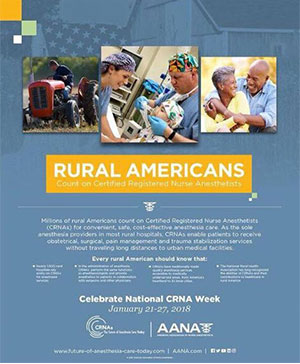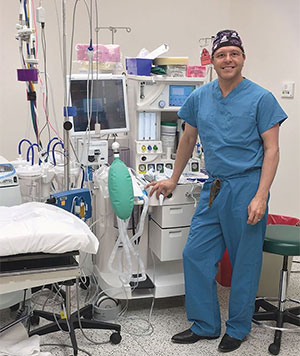Jun 27, 2018
The Rural General Surgeon's Partner: Rural Certified Registered Nurse Anesthetists

For most of rural America, surgical anesthesia needs are provided by a Certified Registered Nurse Anesthetist, or CRNA. Dr. Tyler Hughes, a surgeon from McPherson, Kansas, used one word to describe the rural general surgeon's relationship with CRNAs: partnership.
Dr. Juan Quintana, CRNA, DNP, MHS, and past president of the American Association of Nurse Anesthetists (AANA), agreed that a respectful partnership between surgeons and anesthesia providers defines rural surgery. Quintana has spent nearly 20 years partnering with rural surgeons since first finding his niche in east Texas. He's stayed in a rural area because of the sense of community.
"CRNAs give high-quality, safe anesthesia, we're cost-effective, and we're there to give the right care at the right time," Quintana said, admitting he's been in his community long enough where several generations of families now identify him as the family anesthetist.
"Small communities, families, and friends understand we're the providers who put them to sleep safely," Quintana said. "Sometimes it's even a neighbor who says he's told his cousin's friend to have me do his anesthesia for his upcoming surgery. That just doesn't happen in an urban setting."

A routine day for a rural CRNA might be giving anesthesia to a child who needs ear tubes or an adult patient who's having a hernia repair. Quintana provided a reminder that CRNAs are needed for surgical cases other than those electively scheduled during daytime hours. They're also needed in the middle of the night when a woman needs an emergency Cesarean section because the placenta is blocking the birth canal, or for a patient hemorrhaging from a bleeding stomach ulcer, or for catastrophic trauma: a hand, an arm, a leg severed by motor vehicle accident or work injury.
"When those trauma patients come in the middle of the night, the surgeon and CRNA talk it out," Quintana said. "Who's going to do what. While you do that, I'll do the other thing. They'll do the trach [tracheotomy, a hole in the throat to allow air to get into the lungs], I'll do the central line [a special IV line]. Though we're always a team and checking with each other during any procedure, we're definitely a team under those circumstances."

